2018 MERCEDES-BENZ CLA COUPE lights
[x] Cancel search: lightsPage 31 of 326

The following text is reproduced as required of
all manufacturers under Title 49, Code of U.S.
Federal Regulations, Part 575 pursuant to the
National Traffic and Motor Vehicle Safety Act of
1966.
If you believe that your vehicle hasadefect
which could cause acrash or could cause injury
or death, you should immediately inform the
National Highway Traffic Safety Administration
(NHTSA)ina ddition to notifying Mercedes-Benz
USA,L LC.
If NHTSA receives similar complaints ,itmay
open an investigation, and if it finds that asafety
defect exists in agroup of vehicles, it may order
ar ecall and remedy campaign. However, NHTSA
cannot become involved in individual problems
between you, your dealer, or Mercedes-Benz
USA,L LC.
To contact NHTSA,y ou may call the Vehicle
Safety Hotlin etoll-free at 1-888-327-4236
(TTY: 1-800-424-9153); go tohttp://
www.safercar.gov;orw rite to: Administrator,
NHTSA,4 00 SeventhS treet, SW., Washington,
DC 20590.
You can also obtain other information about
motor vehicle safety from
http://www.safercar.gov
Limited Warranty
!
Follow the instructions in this manual about
the proper operation of your vehicle as well as
about possible vehicle damage. Damage to
your vehicle that arises from culpable contra-
ventions against these instructions is not cov-
ered either by the Mercedes-Benz Limited
Warranty or by the New or Used-Vehicle War-
ranty.
QR codes for the rescue card
The QR codes are secured in the fuel filler flap
and on the opposite side on the B-pillar. In the
event of an accident,r escue services can use
the QR code to quickly find the appropriate res-
cue card for your vehicle. The current rescue
card contains the most important information
about your vehicle in acompact form, e.g. the
routing of the electric cables.
You can find more information under
www.mercedes-benz.de/qr-code.
Data stored in the vehicle
Data storage
Aw ide range of electronic components in your
vehicle contain data memories.
These data memories temporarily or perma-
nently store technical information about:
Rthe vehicle's operating state
Rincidents
Rmalfunctions
In general, this technical information docu-
mentst he state of acomponent, amodule, a
system or the surroundings.
These include, for example:
Roperating conditions of system components,
e.g. fluid levels
Rthe vehicle's status messages and those of its
individual components, e.g. number of wheel
revolutions/speed, deceleration in move-
ment,l ateral acceleration, accelerator pedal
position
Rmalfunction sand defects in important system
components, e.g. lights, brakes
Rvehicle reactionsa nd operating conditions in
special driving situations, e.g. air bag deploy-
ment,i ntervention of stability control sys-
tems
Rambient conditions, e.g. outside temperature
This data is of an exclusively technical nature
and can be used to:
Rassist in recognizing and rectifying malfunc-
tions and defects
Ranalyze vehicle functions, e.g. after an acci-
dent
Roptimize vehicle functions
The data cannot be used to trace the vehicle's
movements.
When your vehicle is serviced, technical infor-
mation can be read from the event data memory
and malfunction data memory.
Services include, for example:
Rrepair services
Rservice processes
Rwarranties
Rquality assurance
The vehicle is read out by employees of the ser-
vice network (including the manufacturer) using special diagnostic testers. More detailed infor-
mation is obtained from it, if required.
Data stored in the vehicle29
Introduction
Z
Page 34 of 326
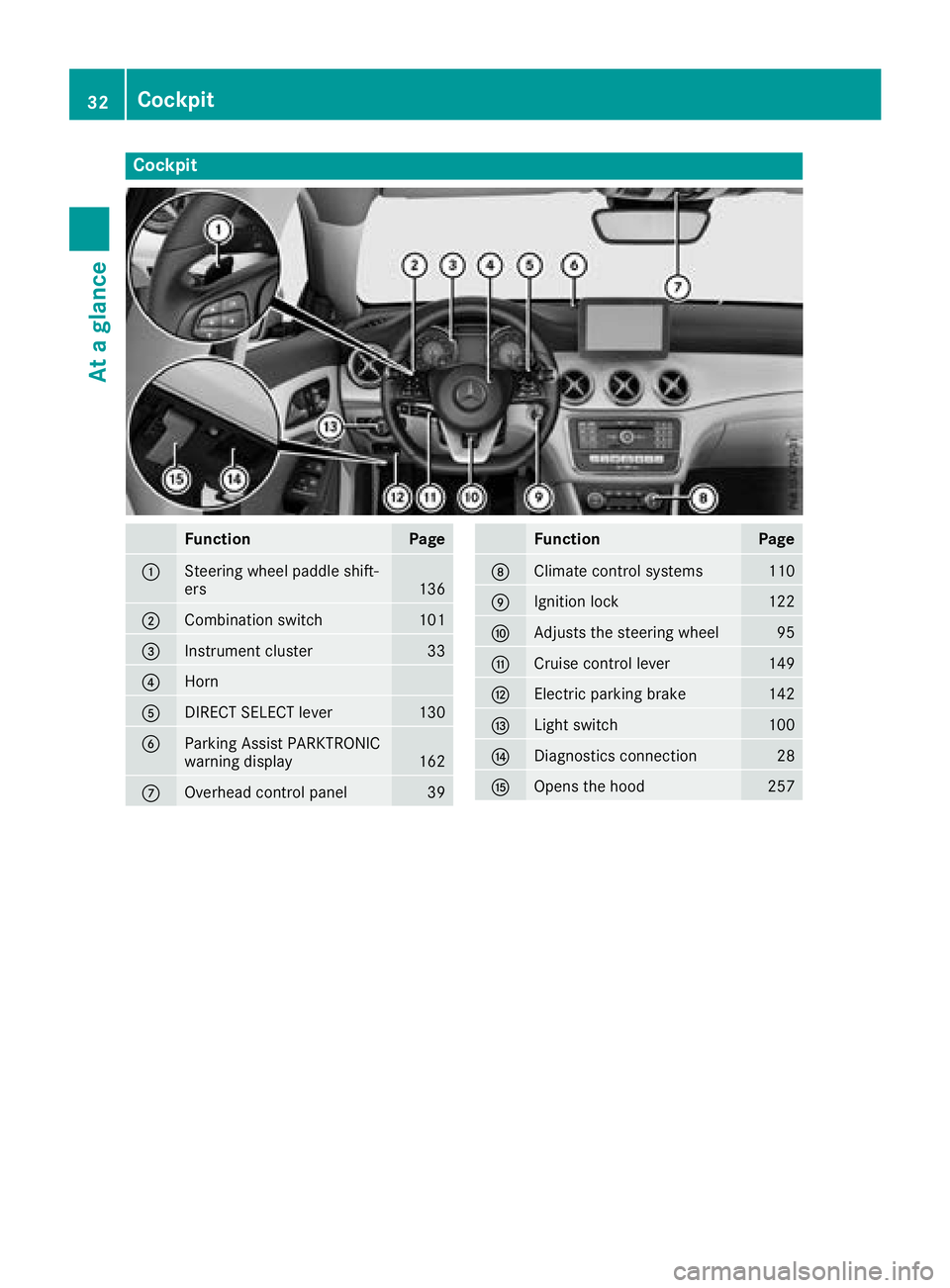
Cockpit
FunctionPage
:Steering wheel paddle shift-
ers136
;Combination switch101
=Instrumentcluster33
?Horn
ADIRECT SELECT lever130
BParking Assist PARKTRONIC
warning display162
COverhead control panel39
FunctionPage
DClimatecontrol systems110
EIgnition lock122
FAdjusts th esteering wheel95
GCruis econtrol lever149
HElectric parking brake142
ILights witch100
JDiagnostics connection28
KOpenst hehood257
32Cockpit
Atag lance
Page 43 of 326

Restraint system warninglamp
The functions of the restraint system are
checke dafterthe ignition is switched on and at
regular interval swhile the engine is running.
Therefore, malfunctions can be detected in
goodt ime.
The 6 restraint system warning lamp on the
instrument cluster lights up when the ignition is
switched on. It goeso utno later than afew sec-
onds afte rthe vehicl eisstarted. The compo-
nents of the restraint system are in operational
readiness.
Am alfunction haso ccurred if the6restraint
system warning lamp:
Rdoe snot light up afte rthe ignition is switched
on
Rdoe snot go outa fteraf ew seconds with the
engine running
Rlights up agai nwhile the engine is running
GWARNING
If the restraint system is malfunctioning,
restraint system components may be trig-
gered unintentionally or may not deplo yas
intended during an accident. Thisc an affect
for exampl ethe Emergency Tensioning
Device or the ai rbag.Thisp oses an increased
ris kofi njury or evenf atalinjury.
Have the restraint system checke dand
repaired in aquali fied specialist workshopa s
soona spossible.
PASSENGER AI RBAG indicator lamp
PASSENGER AIR BAG ON indicator lamp :and
PASSENGER AIR BAG OFF indicator lamp ;are
part of the Occupant Classification System
(OCS). The indicator lamps display the statu
softhe
front-passenger front ai rbag.
RPASSENGER AIR BAG ON lights up for 60 sec-
onds ,sub sequently both indicator lamps are
off (PASSENGER AIR BAG ON and OFF):t he
front-passenger front ai rbag is able to deploy
in the event of an accident.
RPASSENGER AIR BAG OFF lights up :the front-
passenger front ai rbag is deactivated. It will
then not be deploye dinthe event of an acci-
dent.
If the PASSENGER AIR BAG ON indicator lamp is
off, only the PASSENGER AIR BAG OFF indicator lamp shows the statu softhe front-passenger
front ai rbag.T he PASSENGER AIR BAG OFF
indicator lamp may be li tcontinuously or be off.
Depending on the person in the front-passenger
seat, the front-passenger front ai rbag must
either be deactivated or enabled; see the fol-
lowing points. Yo umustm ake sure of this both
before and during ajourney.
RChildreninac hild restraintsystem:
whethert he front-passenger front ai rbag is
enabled or deactivated depends on the instal- le dc hild restraint system, and the ag eand
size of the child .Therefore, be sure to observe
the notes on the "Occupant Classification
System (OCS)" (
Ypage 47 )and on "Chil-
dre nint he vehicle" (Ypage 54). There you
will also find instructions on rearward and
forward-facing child restraint systems on the
front-passenger seat.
RAl lo the rpersons: depending on the classi-
fication of the person in the front-passenger
seat, the front-passenger front ai rbag is ena-
bled or deactivated (
Ypage 47). Be sure to
observe the notes on "Seat
belts“ (
Ypage 41 )and "Ai rbags"
(Ypage 45). There yo ucan also find infor-
mation on the correct seatp osition.
Seat belts
Introduction
Seatb elts are the most effective means of
restricting the movement of vehicl eoccupants
in the event of an accident or the vehicl erolling
over. Thisr educesthe ris kofvehicleoccupants
coming into contact with parts of the vehicle
interio rorbeing ejecte dfrom the vehicle. Fur-
thermore,t he seatbelth elps to keep the vehicle
Occupan tsafety41
Safety
Z
Page 46 of 326
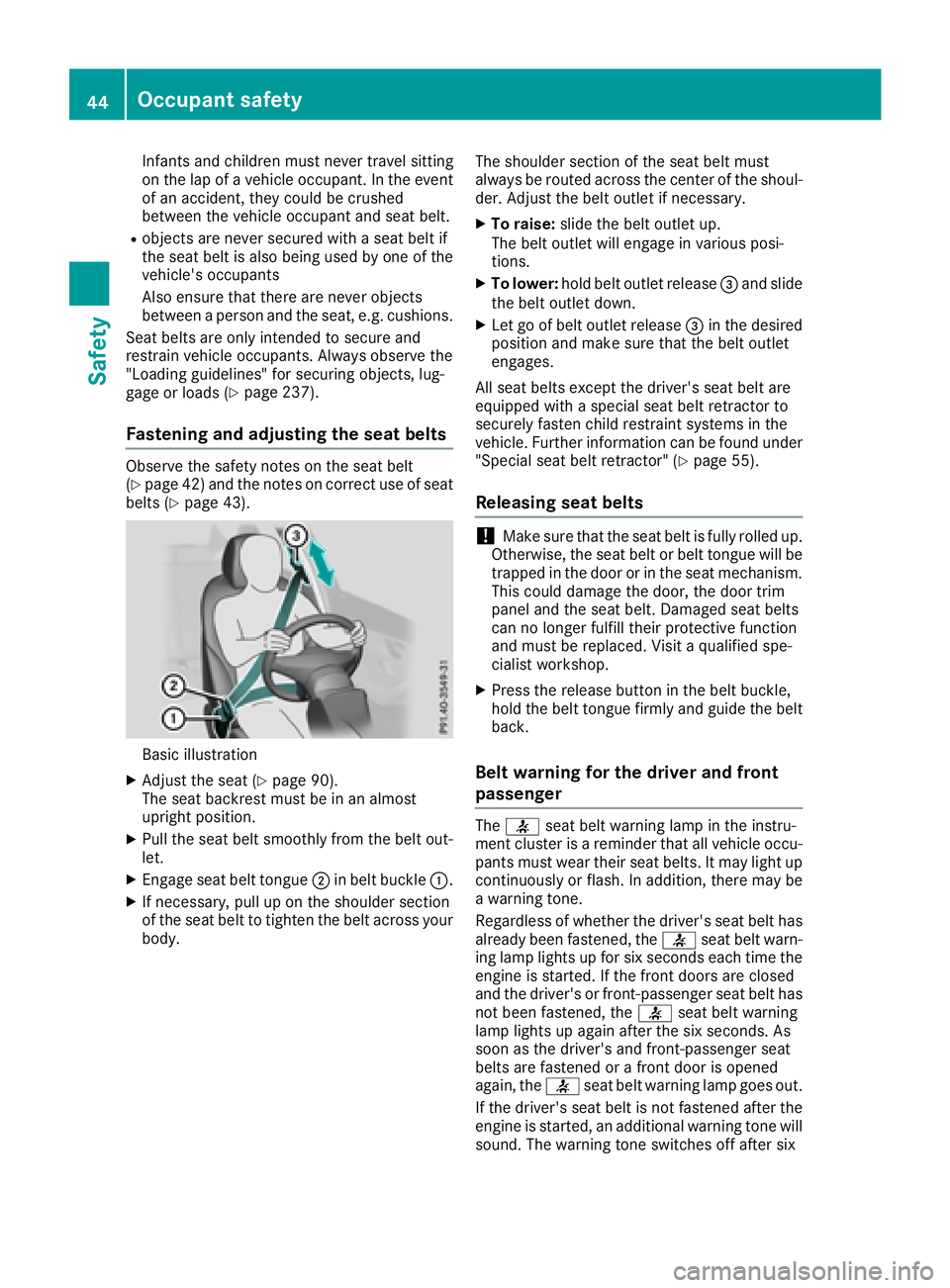
Infants and childrenmust never travel sitting
on the lap of avehicle occupant. In the event
of an accident, they could be crushed
between the vehicle occupant and seat belt.
Robjects are never secured with aseat belt if
the seat belt is also being used by one of the
vehicle's occupants
Also ensure that there are never objects
between aperson and the seat, e.g. cushions.
Seat belts are only intended to secure and
restrain vehicle occupants. Alway sobserve the
"Loading guidelines" for securing objects, lug-
gage or loads(
Ypage 237).
Fastening and adjusting the seat belts
Observe the safety notes on the seat belt
(Ypage 42) and the notes on correct use of seat
belts (Ypage 43).
Basic illustration
XAdjust the seat (Ypage 90).
The seat backrest must be in an almost
upright position.
XPul lthe seat belt smoothly from the belt out-
let.
XEngage seat belt tongue ;in belt buckle :.
XIf necessary,pullupont he shoulder section
of the seat belt to tighten the belt across your
body. The shoulder section of the seat belt must
always be routed across the center of the shoul-
der. Adjust the belt outlet if necessary.
XTo raise:
slidethe belt outlet up.
The belt outlet wille ngage in variousposi-
tions.
XTo lower: hold belt outlet release =and slide
the belt outlet down.
XLet go of belt outlet release =in the desired
positiona nd make sure that the belt outlet
engages.
All seat belts except the driver's seat belt are
equipped with aspecials eat belt retractor to
securelyf asten child restraint systems in the
vehicle.F urther information can be found under
"Specials eat belt retractor" (
Ypage 55).
Releasing seat belts
!Make sure that the seat belt is fullyr olledup.
Otherwise,t he seat belt or belt tongue willb e
trapped in the door or in the seat mechanism.
This could damage the door, the door trim
panel and the seat belt. Damaged seat belts
can no longer fulfill their protective function
and must be replaced. Visit aqualifieds pe-
cialist workshop.
XPress the release button in the belt buckle,
hold the belt tongue firmly and guide the belt
back.
Belt warning for the driver and front
passenger
The 7 seat belt warning lamp in the instru-
ment cluster is areminder that all vehicle occu-
pants must weart heir seat belts. It may light up
continuously or flash. In addition, there may be
aw arning tone.
Regardless of whether the driver's seat belt has
already been fastened, the 7seat belt warn-
ing lamp lights up for six seconds each time the engine is started. If the front doors are closed
and the driver's or front-passenger seat belt has
not been fastened, the 7seat belt warning
lamp lights up again after the six seconds. As
soon as the driver's and front-passenger seat
belts are fastened or afront door is opened
again, the 7seat belt warning lamp goes out.
If the driver's seat belt is not fastened after the
engine is started, an additional warning tone will sound. The warning tone switches off after six
44Occupant safety
Safety
Page 50 of 326
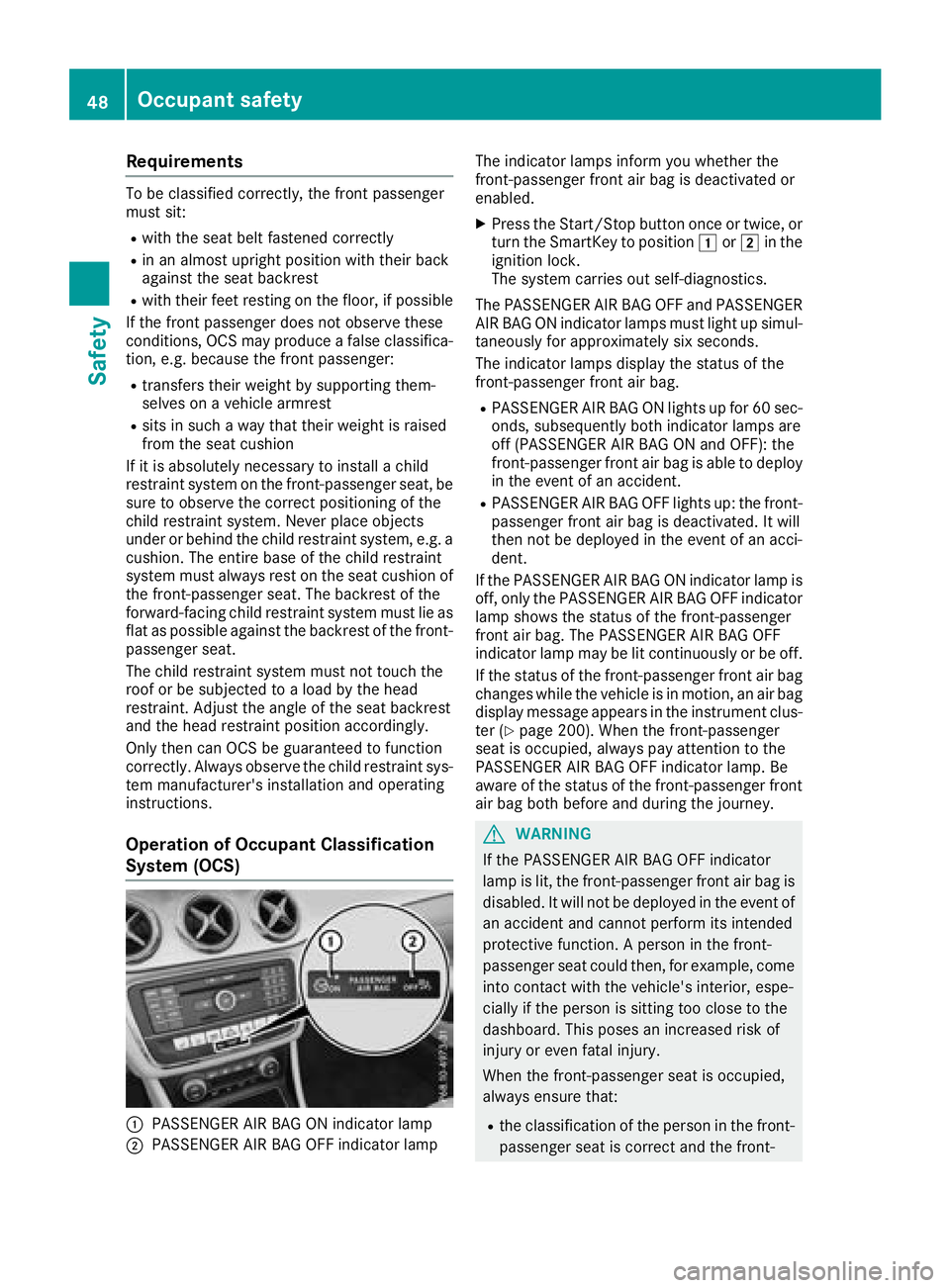
Requirements
To be classifiedcorrectly ,the front passenger
mus tsit:
Rwith the seatb eltf astened correctly
Rin an almost upright position with theirb ack
against the seatb ackrest
Rwith theirf eetresting on the floor, if possible
If the front passenger doe snot observe these
conditions ,OCS may produce afalse classifica-
tion, e.g. because the front passenger:
Rtransfers theirw eightbys uppo rting them-
selves on avehicl earmrest
Rsits in such awaythat theirw eightisr aised
from the seatc ushion
If it is absolutely necessary to install achild
restraint system on the front-passenger seat, be
sure to observe the correct positioning of the
child restraint system. Neverp lace objects
under or behind the child restraint system, e.g. a
cushion. The entir ebaseoft he child restraint
system mus talway srestont he seatc ushionof
the front-passenger seat. The backrest of the
forward-facing child restraint system mus tlie as
fla tasp ossible against the backrest of the front-
passenger seat.
The child restraint system mus tnot touch the
rooforbes ubjecte dtoal oadbyt he head
restraint. Adjust the angle of the seatb ackrest
and the headr estraint position accordingly.
Only then can OCSbeg uaranteed to function
correctly .Alway sobserve the child restraint sys-
tem manufacturer'si nstallationand o
perating
instructions.
OperationofO ccupant Classification
System (OCS)
:PASSENGER AIR BAG ON indicator lamp
;PASSENGER AIR BAG OFF indicator lamp The indicator lamps inform yo
uwhethe rthe
front-passenger front ai rbag is deactivated or
enabled.
XPress the Start/Sto pbutton once or twice, or
turn the SmartKey to position 1or2 in the
ignition lock.
The system carrie soutself-diagnostics.
The PASSENGER AIR BAG OFF and PASSENGER
AIR BAG ON indicator lamps mus tlight up simul-
taneously for approximately six seconds.
The indicator lamps display the statu softhe
front-passenger front ai rbag.
RPASSENGER AIR BAG ON lights up for 60 sec-
onds ,sub sequently both indicator lamps are
off (PASSENGER AIR BAG ON and OFF):t he
front-passenger front ai rbag is able to deploy
in the event of an accident.
RPASSENGER AIR BAG OFF lights up :the front-
passenger front ai rbag is deactivated. It will
then not be deploye dinthe event of an acci-
dent.
If the PASSENGER AIR BAG ON indicator lamp is
off, only the PASSENGER AIR BAG OFF indicator lamp shows the statu softhe front-passenger
front ai rbag.T he PASSENGER AIR BAG OFF
indicator lamp may be li tcontinuously or be off.
If the statu softhe front-passenger front ai rbag
changes whil ethe vehicl eisinmotion, an ai rbag
display message appears in the instrument clus-
ter (
Ypage 200). Whent he front-passenger
seati soccupied, always pa yattention to the
PASSENGER AIR BAG OFF indica tor l
amp. Be
aware of the statu softhe front-passenger front
ai rb ag both before and during the journey.
GWARNING
If the PASSENGER AIR BAG OFF indicator
lamp is lit, the front-passenger front ai rbag is
disabled. It will not be deploye dinthe event of
an accident and canno tperform its intended
protectiv efunction. Aperson in the front-
passenger seatc ould then, for example, come
into contact with the vehicle's interior, espe-
ciall yift he person is sitting too close to the
dashboard. Thisp oses an increased ris kof
injury or evenf atalinjury.
Whent he front-passenger seati soccupied,
always ensure that:
Rthe classification of the person in the front- passenger seati scorrect and the front-
48Occupan tsafety
Safety
Page 51 of 326
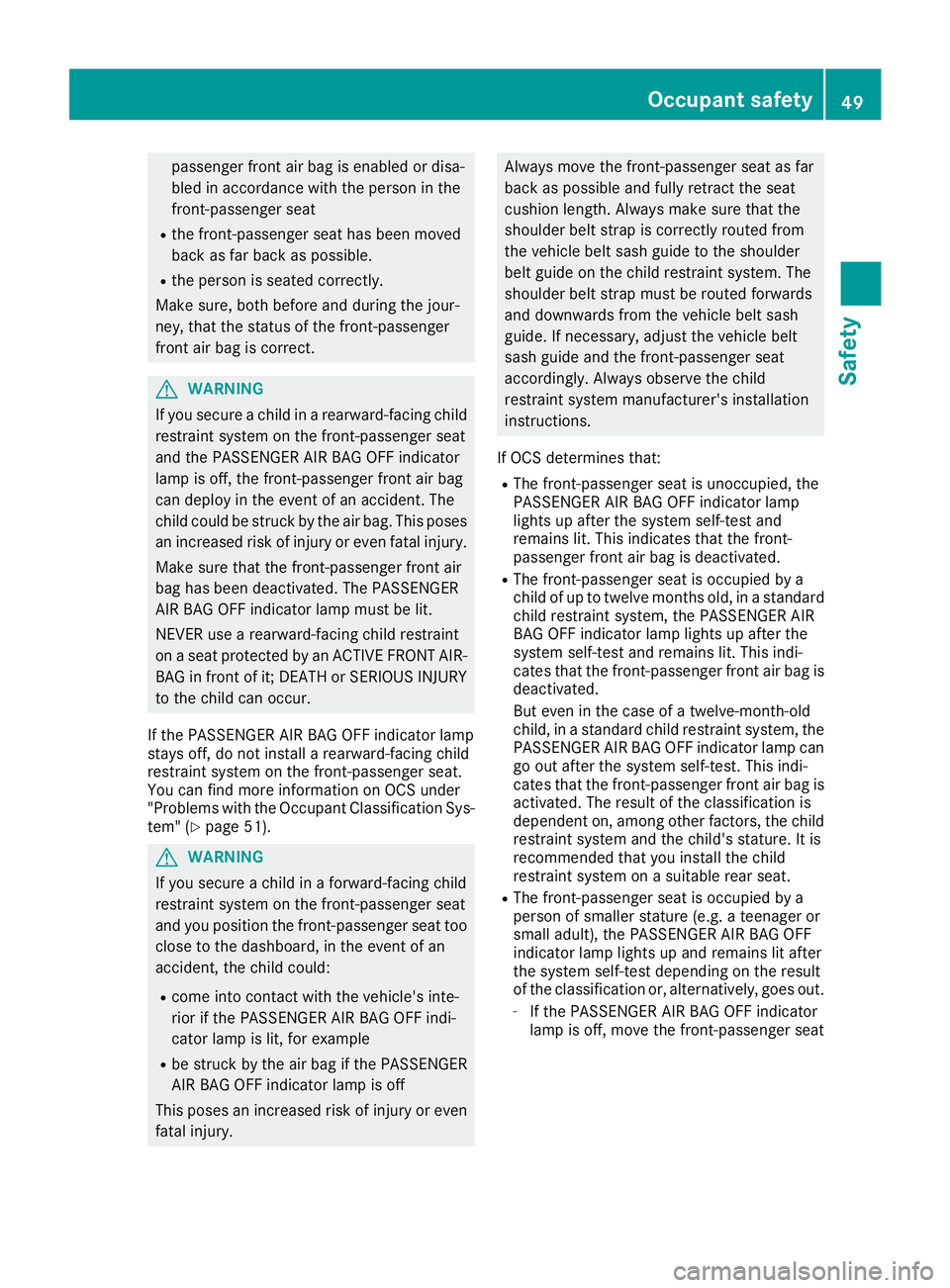
passenger frontair bag is enabled or disa-
bled in accordance with the person in the
front-passenger seat
Rthe front-passenger seat has been moved
back as far back as possible.
Rthe person is seated correctly.
Make sure, both before and during the jour-
ney, that the status of the front-passenger
fronta ir bag is correct.
GWARNING
If you secure achild in arearward-facing child
restraint system on the front-passenger seat
and the PASSENGER AIR BAGO FF indicator
lamp is off, the front-passenger fronta ir bag
can deploy in the event of an accident. The
child could be struck by the air bag. This poses an increased risk of injury or even fatal injury.
Make sure that the front-passenger fronta ir
bag has been deactivated. The PASSENGER
AIR BAGO FF indicator lamp must be lit.
NEVER use arearward-facing child restraint
on aseat protected by an ACTIVE FRONT AIR-
BAGinf rontofit; DEATH or SERIOUS INJURY
to the child can occur.
If the PASSENGER AIR BAGO FF indicator lamp
stays off, do not install arearward-facing child
restraint system on the front-passenger seat.
You can find more information on OCS under
"Problems with the Occupant Classification Sys-
tem" (
Ypage 51).
GWARNING
If you secure achild in aforward-facingc hild
restraint system on the front-passenger seat
and you position the front-passenger seat too close to the dashboard, in the event of an
accident, the child could:
Rcome int ocontact with the vehicle's inte-
rior if the PASSENGER AIR BAGO FF indi-
cator lamp is lit, for example
Rbe struck by the air bag if the PASSENGER
AIR BAGO FF indicator lamp is off
This poses an increased risk of injury or even fatal injury.
Always move the front-passenger seat as far
back as possible and fully retract the seat
cushion length. Always make sure that the
shoulder belt strap is correctly routed from
the vehicle belt sash guide to the shoulder
belt guide on the child restraint system. The
shoulder belt strap must be routed forwards
and downwards from the vehicle belt sash
guide. If necessary, adjust the vehicle belt
sash guide and the front-passenger seat
accordingly. Always observe the child
restraint system manufacturer's installation
instructions.
If OCS determines that:
RThe front-passenger seat is unoccupied, the
PASSENGER AIR BAGO FF indicator lamp
lights up after the system self-test and
remains lit. This indicates that the front-
passenger fronta ir bag is deactivated.
RThe front-passenger seat is occupied by a
child of up to twelve months old, in astandard
child restraint system, the PASSENGER AIR
BAGO FF indicator lamp lights up after the
system self-test and remains lit. This indi-
cates that the front-passenger fronta ir bag is
deactivated.
But even in the case of atwelve-month-old
child, in astandard child restraint system, the
PASSENGER AIR BAGO FF indicator lamp can
go out after the system self-test. This indi-
cates that the front-passenger fronta ir bag is
activated. The result of the classification is
dependen ton, among other factors, the child
restraint system and the child's stature. It is
recommended that you install the child
restraint system on asuitable rear seat.
RThe front-passenger seat is occupied by a
person of smaller stature (e.g. ateenager or
small adult), the PASSENGER AIR BAGO FF
indicator lamp lights up and remains lit after
the system self-test dependin gonthe result
of the classification or, alternatively, goes out.
-If the PASSENGER AIR BAGO FF indicator
lamp is off, move the front-passenger seat
Occupant safety49
Safety
Z
Page 53 of 326
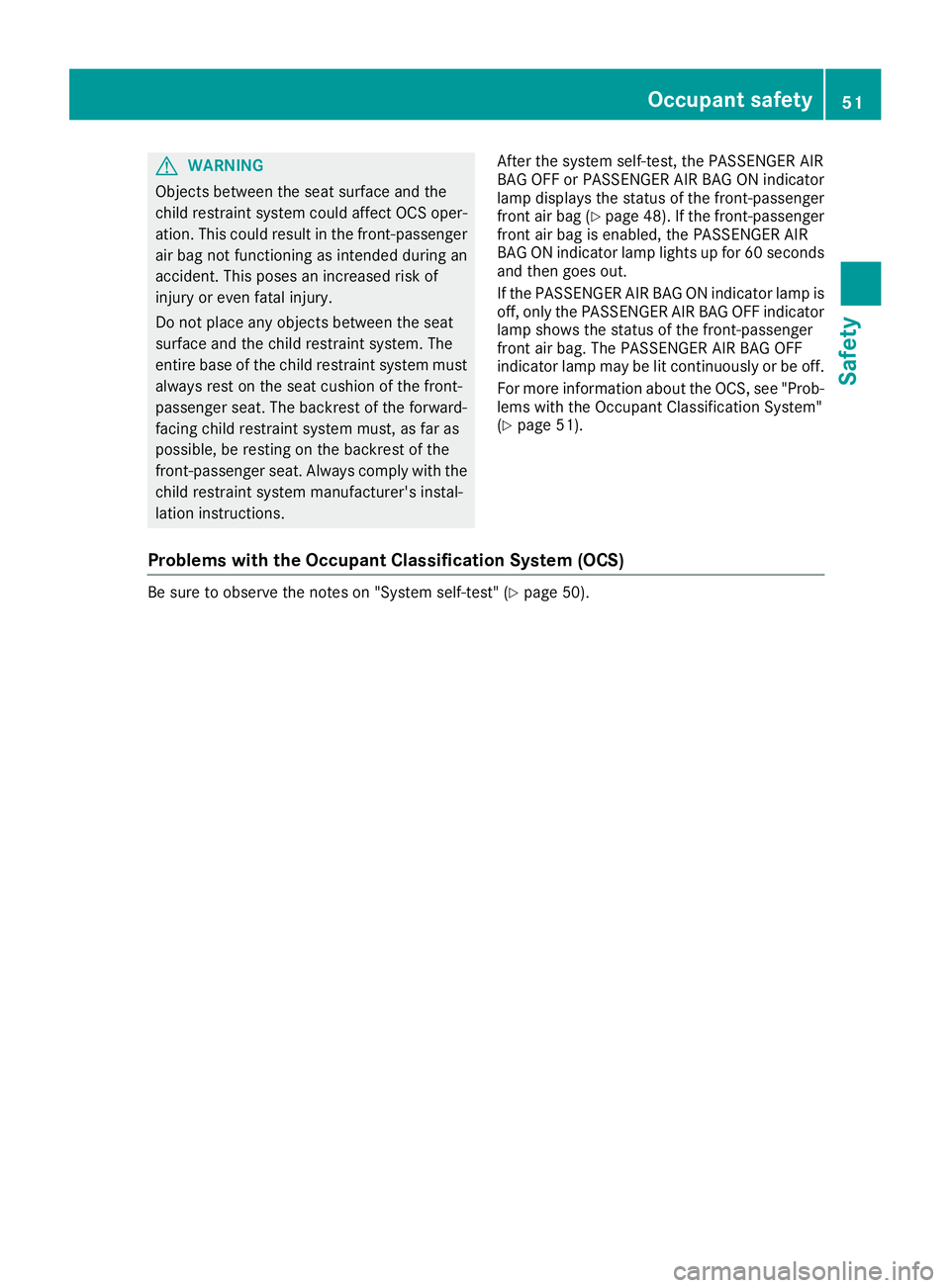
GWARNING
Objects between the seat surface and the
child restraint system coul daffect OCS oper-
ation. This coul dresult in the front-passenger
air bag not functioning as intended during an
accident. This poses an increased risk of
injury or even fatal injury.
Do not place any objects between the seat
surface and the child restraint system. The
entire base of the child restraint system must
alway srest on the seat cushion of the front-
passenger seat. The backrest of the forward-
facing child restraint system must, as far as
possible,ber esting on the backrest of the
front-passenge rseat. Always comply with the
child restraint system manufacturer's instal-
lation instructions. After the system self-test, the PASSENGER AIR
BAG OFF or PASSENGER AIR BAG ON indicator
lamp display
sthe status of the front-passenger
front air bag (
Ypage4 8). If the front-passenger
front air bag is enabled, the PASSENGER AIR
BAG ON indicator lamp lights up for 60 seconds and then goes out.
If the PASSENGER AIR BAG ON indicator lamp is
off, only the PASSENGER AIR BAG OFF indicator
lamp showst he status of the front-passenger
front air bag.T he PASSENGER AIR BAG OFF
indicator lamp may be lit continuously or be off.
For more information about the OCS, see "Prob-
lems with the Occupant Classification System"
(
Ypage5 1).
Problems with the Occupant Classificatio nSystem (OCS)
Be sure to observe the notes on "System self-test" (Ypag e50).
Occupant safety51
Safety
Z
Page 54 of 326
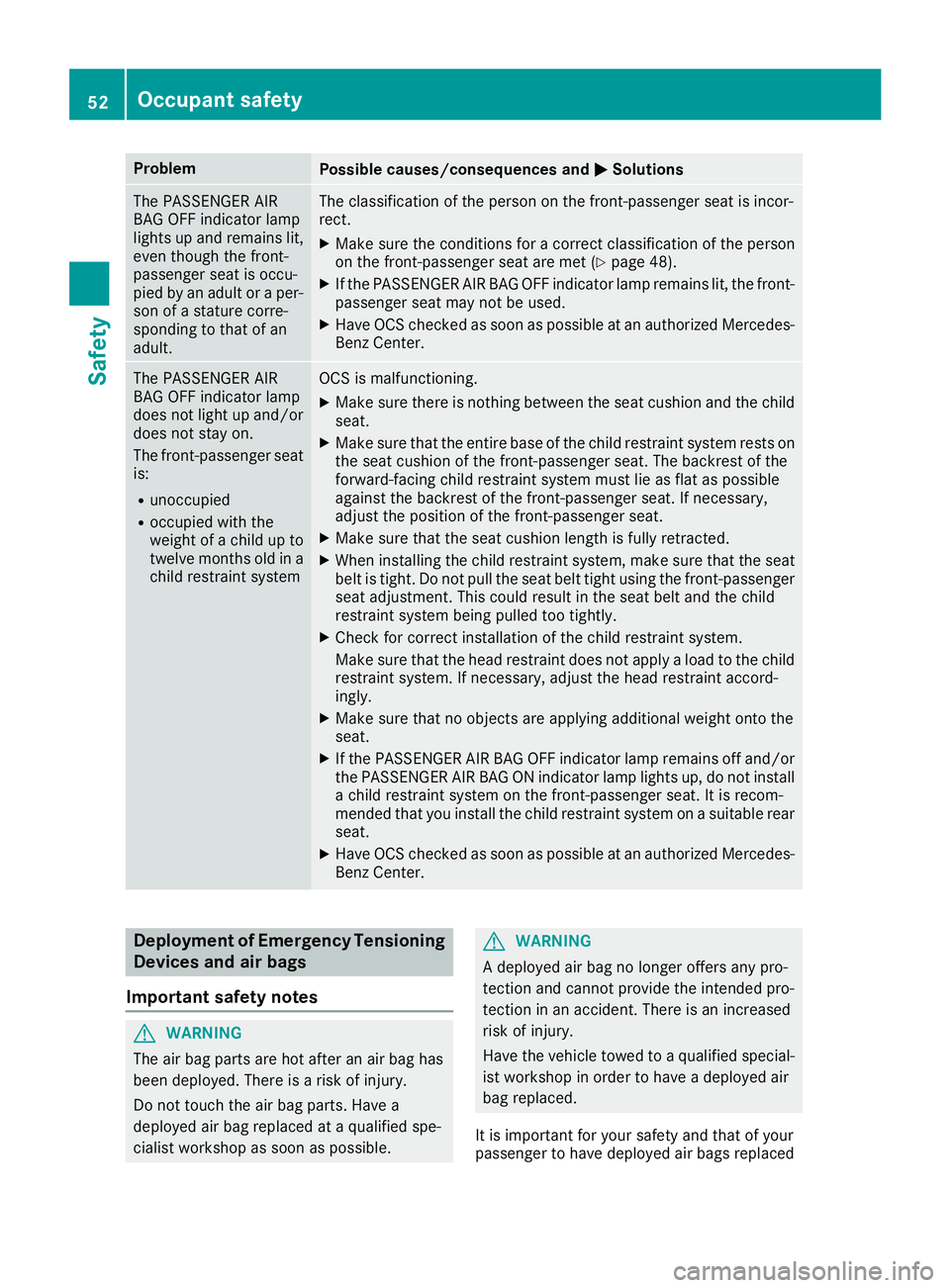
ProblemPossible causes/consequences andMSolutions
The PASSENGER AIR
BAG OFF indicator lamp
lights up and remains lit,
even though the front-
passenger seat is occu-
pied by an adult oraper-
son of astature corre-
sponding to that of an
adult.The classification of the person on the front-passenger seat is incor-
rect.
XMake sure the conditionsf orac orrect classification of the person
on the front-passenger seat are met (Ypage 48).
XIf the PASSENGER AIR BAG OFF indicator lamp remains lit, the front-
passenger seat may not be used.
XHave OCS checked as soon as possible at an authorized Mercedes- Benz Center.
The PASSENGER AIR
BAG OFF indicator lamp
does not light up and/or
does not stay on.
The front-passenger seat
is:
Runoccupied
Roccupied with the
weight of achild up to
twelve months old in a
child restraint system
OCS is malfunctioning.
XMake sure there is nothin gbetween the seat cushion and the child
seat.
XMake sure that the entire base of the child restraint system rests on
the seat cushion of the front-passenger seat. The backrest of the
forward-facing child restraint system must lie as flat as possible
against the backrest of the front-passenger seat. If necessary,
adjust the position of the front-passenger seat.
XMake sure that the seat cushion length is fully retracted.
XWhen installing the child restraint system, make sure that the seat
belt is tight. Do not pull the seat belt tight using the front-passenger seat adjustment .This could result in the seat belt and the child
restraint system being pulled too tightly.
XCheck for correct installation of the child restraint system.
Make sure that the head restraint does not apply aload to the child
restraint system. If necessary, adjust the head restraint accord-
ingly.
XMake sure that no object sare applying additional weight onto the
seat.
XIf the PASSENGER AIR BAG OFF indicator lamp remains off and/or
the PASSENGER AIR BAG ON indicator lamp lights up, do not install ac hild restraint system on the front-passenger seat. It is recom-
mended that you install the child restraint system on asuitable rear
seat.
XHave OCS checked as soon as possible at an authorized Mercedes- Benz Center.
Deployment of Emergency Tensioning
Devices and air bags
Important safety notes
GWARNING
The air bag parts are hot after an air bag has
been deployed. There is arisk of injury.
Do not touch the air bag parts. Have a
deployeda ir bag replaced at aqualified spe-
cialist workshop as soon as possible.
GWARNING
Ad eployeda ir bag no longer offers any pro-
tection and cannot provide the intended pro-
tection in an accident. There is an increased
risk of injury.
Have the vehicle towed to aqualified special-
ist workshop in order to have adeployeda ir
bag replaced.
It is important for your safety and that of your
passenger to have deployeda ir bags replaced
52Occupant safety
Safety